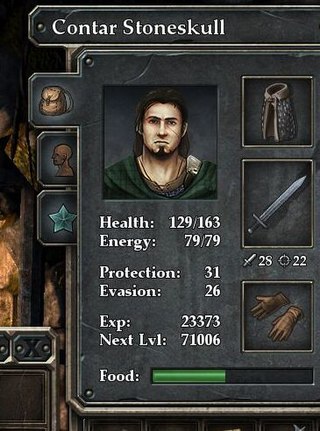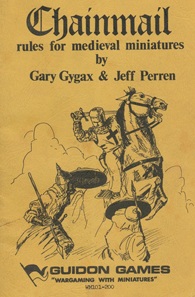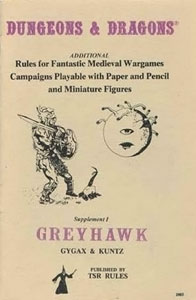Related Research Articles

Ernest Gary Gygax was an American game designer and author best known for co-creating the pioneering tabletop role-playing game Dungeons & Dragons (D&D) with Dave Arneson.

Wētā Workshop is a special effects and prop company as well as a board game and miniatures company and video game developer based in Miramar, Wellington, New Zealand. It mainly produces effects for television and film.

An experience point is a unit of measurement used in some tabletop role-playing games (RPGs) and role-playing video games to quantify a player character's life experience and progression through the game. Experience points are generally awarded for the completion of objectives, overcoming obstacles and opponents, and successful role-playing.
In tabletop games and video games, a character class is an occupation, profession, or role assigned to a game character to highlight and differentiate their capabilities and specializations.

In miniature wargaming, players enact simulated battles using scale models called miniature models, which can be anywhere from 2 to 54 mm in height, to represent warriors, vehicles, artillery, buildings, and terrain. These models are colloquially referred to as miniatures or minis.
Miniatures games are a form of tabletop game which prominently features the use of miniature models or figures.

Chainmail is a medieval miniature wargame created by Gary Gygax and Jeff Perren. Gygax developed the core medieval system of the game by expanding on rules authored by his fellow Lake Geneva Tactical Studies Association (LGTSA) member Jeff Perren, a hobby-shop owner with whom he had become friendly. Guidon Games released the first edition of Chainmail in 1971.

House rules are unofficial modifications to official game rules adopted by individual groups of players. House rules may include the removal or alteration of existing rules, or the addition of new rules. Such modifications are common in board games such as Monopoly and role-playing games such as Dungeons & Dragons.

A fantasy wargame is a wargame that involves a fantastical setting, and employs rules for elements such as magic and non-human intelligent creatures.

A man-to-man wargame is a wargame in which units generally represent single individuals or weapons systems, and are rated not only on weaponry but may also be rated on such facets as morale, perception, skill-at-arms, etc. The game is designed so that a knowledge of military tactics, especially at the small unit or squad level, will facilitate successful gameplay. Man-to-man wargames offer an extreme challenge to the designer, as fewer variables or characteristics inherent in the units being simulated are directly quantifiable. Modern commercial board wargaming stayed away from man-to-man subjects for many years, though once the initial attempts were made to address the subject, it has evolved into a popular topic among wargamers.

Rob Heinsoo is an American tabletop game designer. He has been designing and contributing to professional role-playing games, card games, and board games since 1994. Heinsoo was the lead designer on the 4th Edition of Dungeons & Dragons (2008), and is co-designer of the 13th Age roleplaying game along with Jonathan Tweet. He has also designed and contributed to role playing, miniatures and card games, and a computer game.

Kobolds are a fictional race of humanoid creatures featured in the Dungeons & Dragons roleplaying game and other fantasy media. They are often depicted as small reptilian humanoids with long tails, distantly related to dragons.
Guidon Games produced board games and rulebooks for wargaming with miniatures, and in doing so influenced Tactical Studies Rules, the publisher of Dungeons & Dragons. The Guidon Games publishing imprint was the property of Lowrys Hobbies, a mail-order business owned by Don and Julie Lowry. About a dozen titles were released under the imprint from 1971 to 1973.

The Castle & Crusade Society was a chapter of the International Federation of Wargaming dedicated to medieval miniature wargaming.
Don Lowry is a wargamer, businessman, illustrator, and game designer who is best known as the publisher of Chainmail and the editor of Panzerfaust Magazine.

Health is a video game or tabletop game quality that determines the maximum amount of damage or fatigue something takes before leaving the main game. In role-playing games, this typically takes the form of hit points (HP), a numerical attribute representing the health of a character or object. The game character can be a player character, a boss, or a mob. Health can also be attributed to destructible elements of the game environment or inanimate objects such as vehicles and their individual parts. In video games, health is often represented by visual elements such as a numerical fraction, a health bar or a series of small icons, though it may also be represented acoustically, such as through a character's heartbeat.

Greyhawk is a rules supplement written by Gary Gygax and Robert J. Kuntz and published for the original edition of the Dungeons & Dragons (D&D) fantasy role-playing game. It has been called "the first and most important supplement" to the original D&D rules. Although the name of the book was taken from the home campaign supervised by Gygax and Kuntz based on Gygax's imagined Castle Greyhawk and the lands surrounding it, Greyhawk did not give any details of the castle or the campaign world; instead, it explained the rules that Gygax and Kuntz used in their home campaign, and introduced a number of character classes, spells, concepts and monsters used in all subsequent editions of D&D.

Swords & Spells is a supplementary rulebook by Gary Gygax for the original edition of the Dungeons & Dragons fantasy role-playing game. Its product designation is TSR 2007.
Timothy James Kask is an American editor and writer in the role-playing game industry. Kask became interested in board games in his childhood, and later turned to miniatures wargames. While attending university after a stint in the US Navy, he was part of a group that playtested an early version of the new role-playing game Dungeons & Dragons (D&D) for game co-designer Gary Gygax. Gygax hired him as the first employee of TSR, Inc. in 1975. After editing some of TSR's early D&D publications, Kask became editor of The Strategic Review, which later became The Dragon, and then Dragon Magazine.
Sam Wood is an artist whose work has appeared in role-playing games.
References
- ↑ "Chainmail". Boardgamegeek. 1971. Retrieved 11 January 2025.